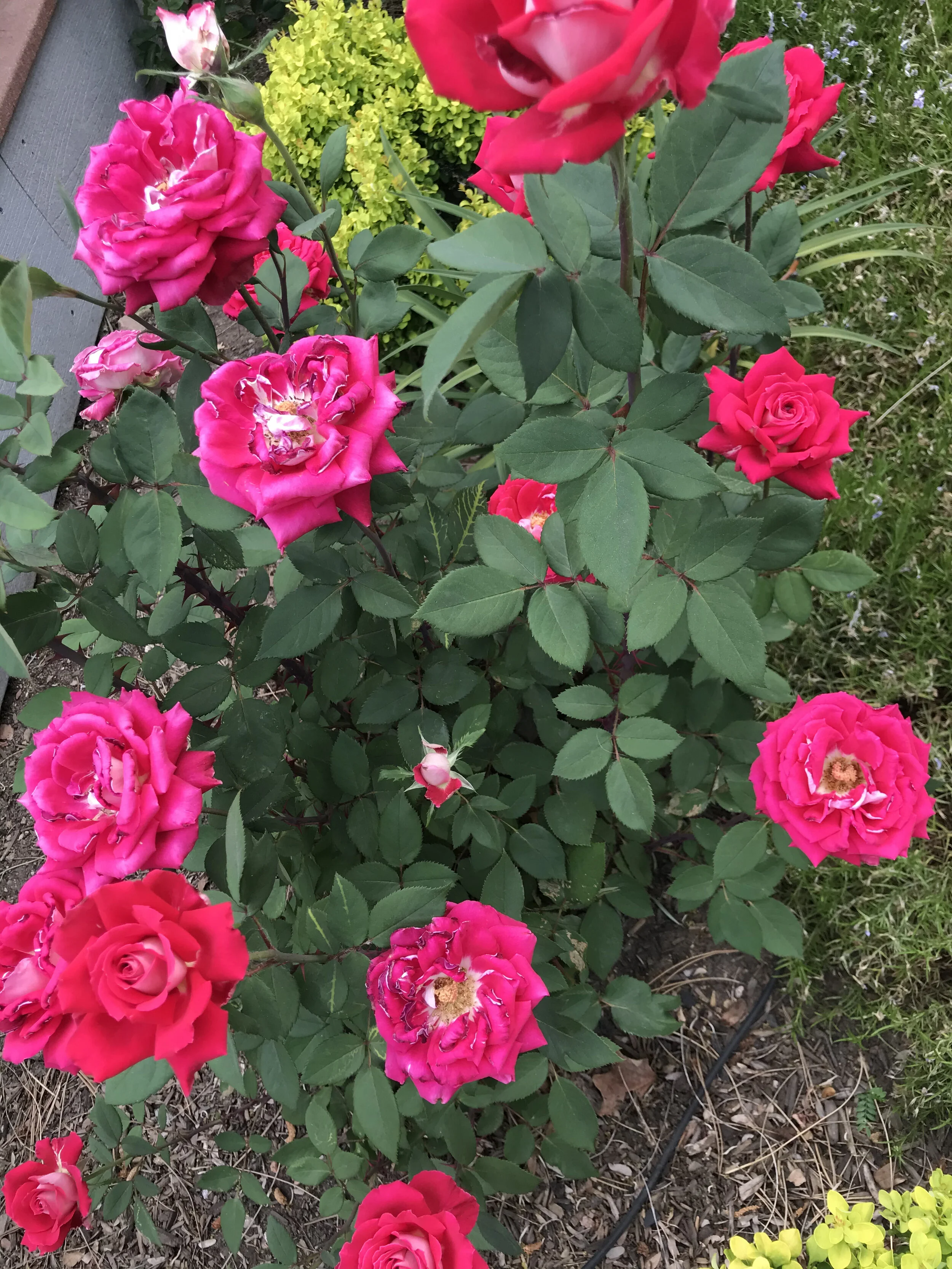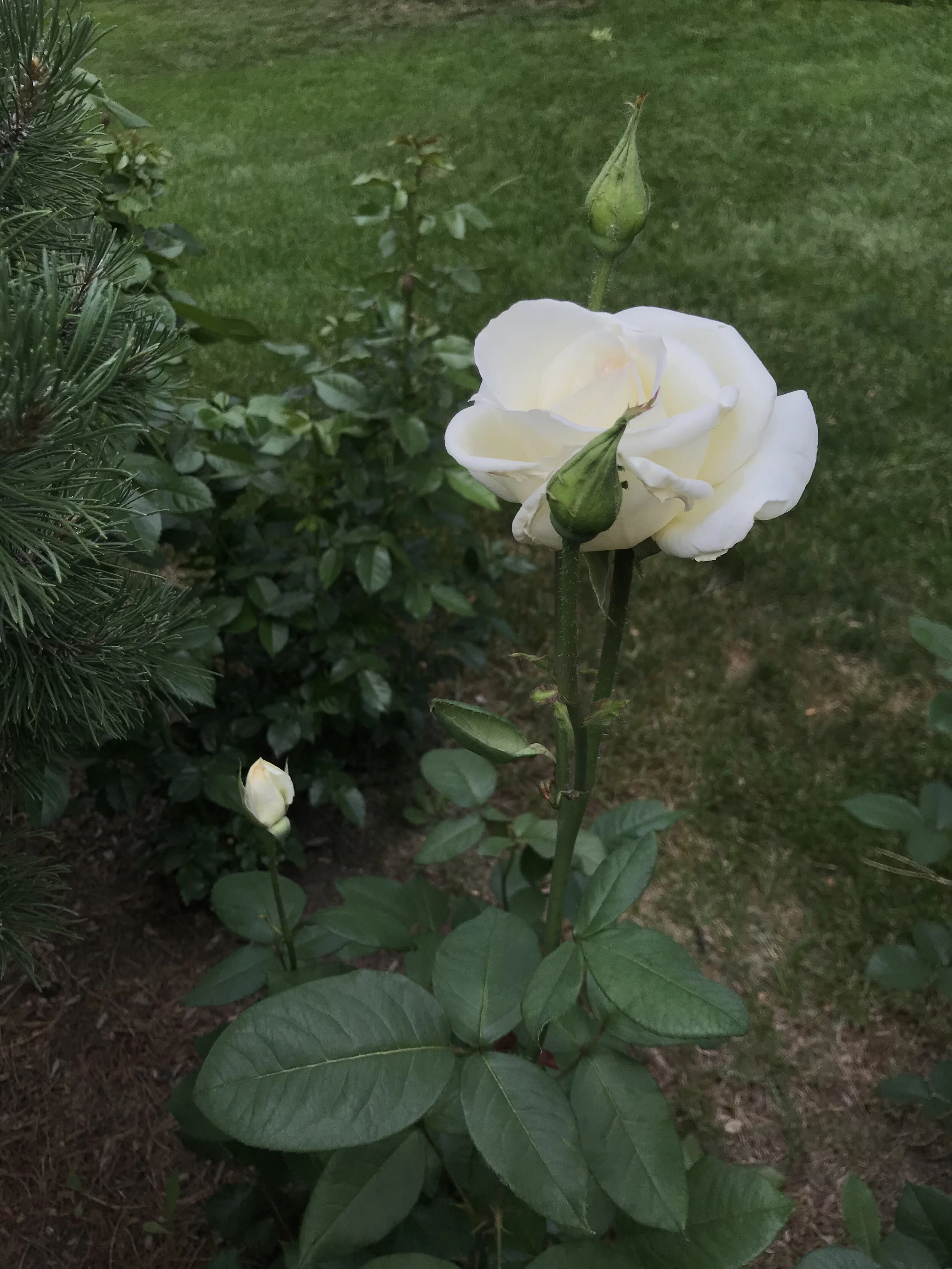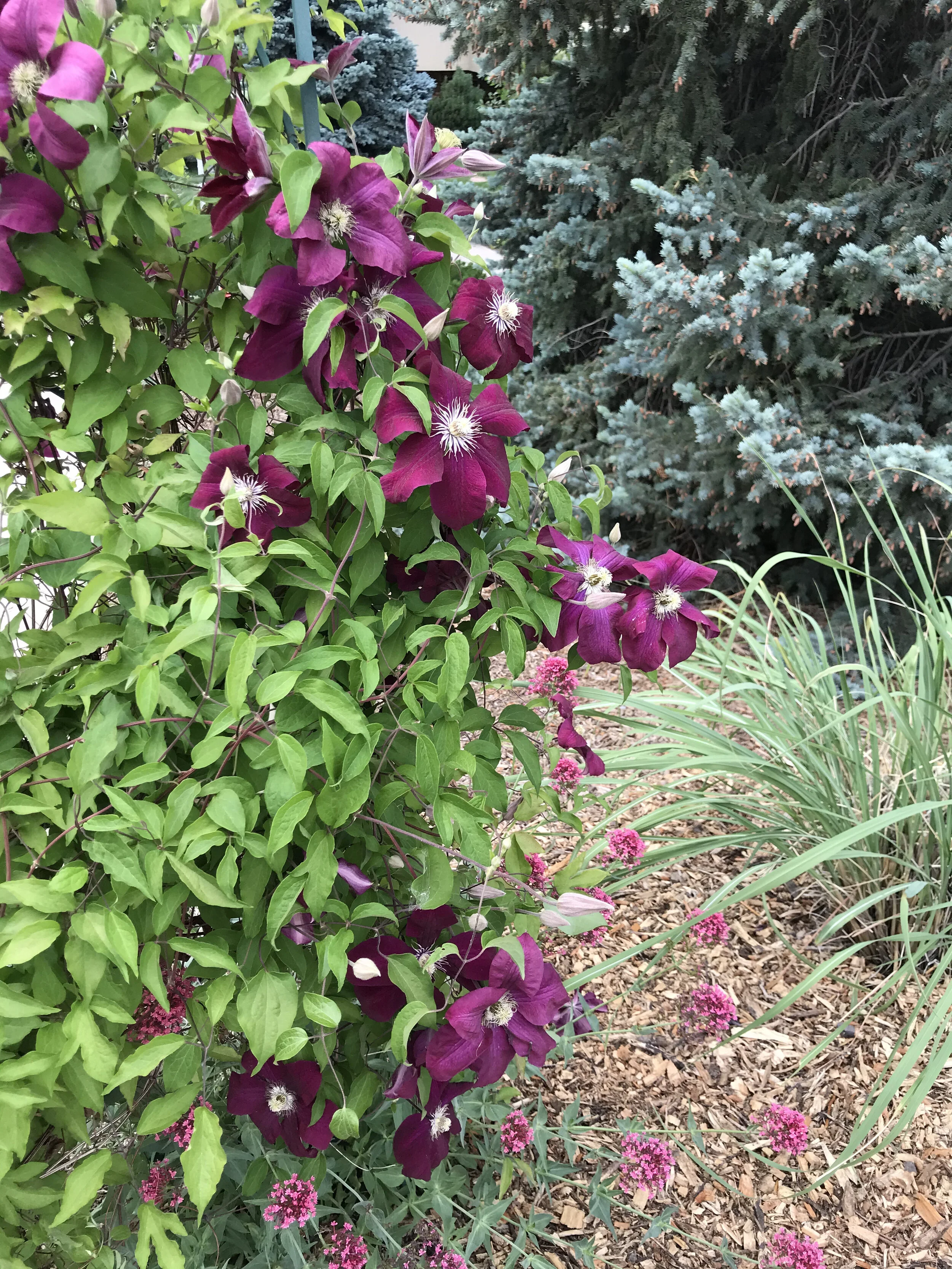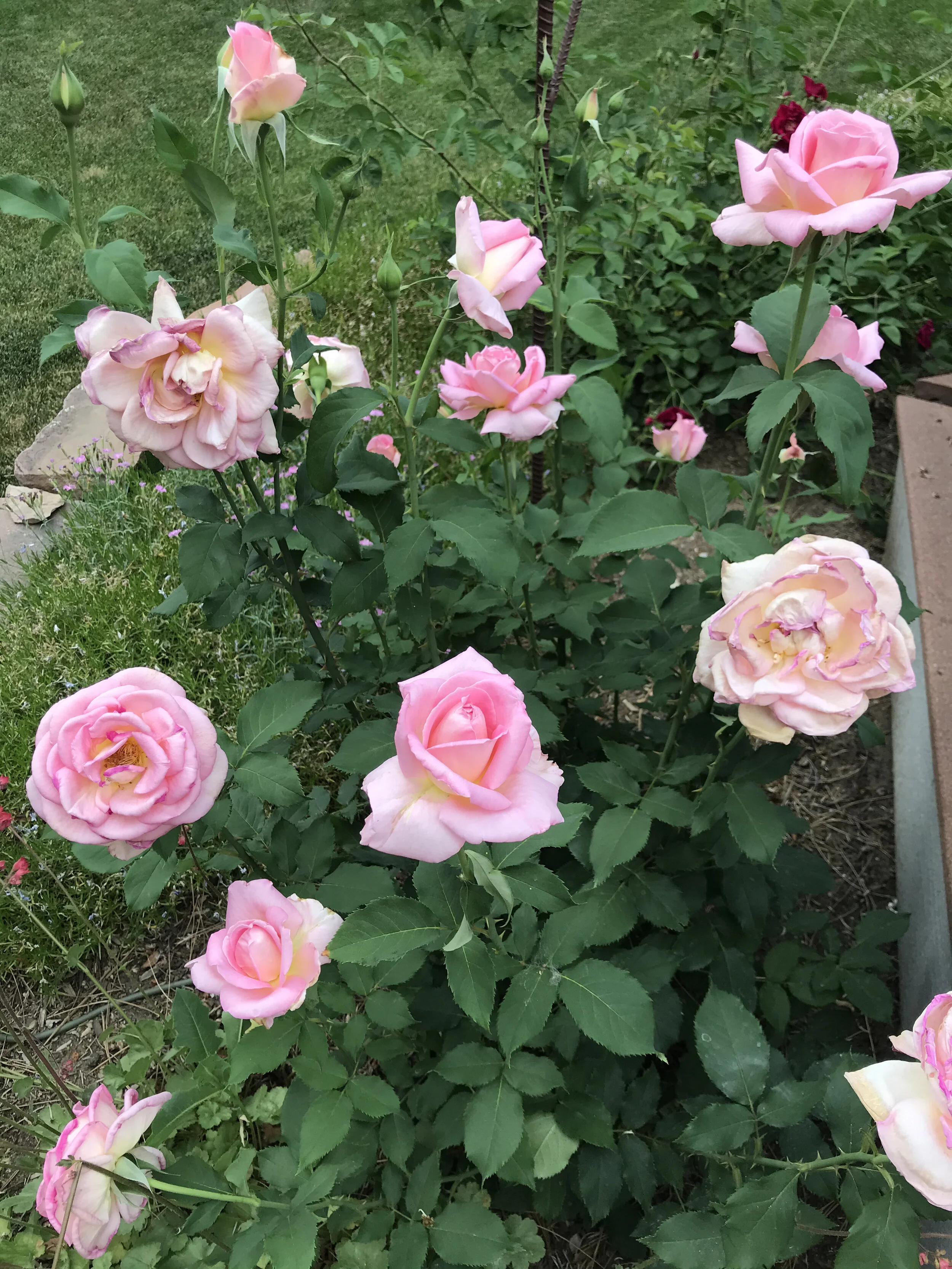A Utopia from the Top Down
My dad’s roses are blooming. Because of all the rain Colorado got earlier this summer, the blooms are huge now. The pink rosebush has seven or eight flowers, bobbing at the tips of its long, spiked stems, each flower bigger than my fist. There are pink roses, fuchsia-red roses, deep magenta roses, luscious peach-colored roses, and one white flower tucked away near the pine bushes. In the front yard my mom has a trellis covered in clematis and a hedge of bowing, heavy-headed peonies.
After three weeks of in-between-semester vacation while living at my parents’ house, my next online school residency starts tomorrow, which means this period of limbo is changing shape, approaching the end even if it hasn’t reached it yet. Moving into our own place is becoming more and more imaginable.
Diego and Maria, the couple who are moving out of the house we’ll move into, invited Michael and me to their farewell block party last night. A handful of couples brought REI camp chairs and a cooler of spiked seltzer and beer over to a rare empty lot at the bottom of our new street. A corner lot in the neighborhood, the kids called it ‘the pit’ because of the massive earthen shelf that revealed where a basement was once built. Evidently the man who’d lived there tore down his house but never got around to building a new one.
“But the same guy still owns it,” one of the new neighbors told us: Brian, a tall, broad-shouldered man with celebrity-white teeth. His petite wife sported a massive diamond ring on her left hand. “Still pays the property taxes, which from what I understand are more expensive if the land is vacant, because Boulder wants all the available residential space to be used.”
Boulder is a small place, made even smaller by the surrounding green belt. The city is nestled against the mountains, and the city government has been buying up surrounding farmland for decades to restrict urban sprawl. Most of it is dedicated open space, creating a network of hundreds of miles of walking, hiking, and biking trails. The large swath of undeveloped land—touted as one of Boulder’s great amenities, making the area more desirable—artificially restricts the housing supply. Land values within the city increase, creating profit for private landowners and major institutions, generating higher property tax revenues for the city. The housing market squeeze is compounded by the student population, since most of them are subsidized by parents willing to shell out $1500 a month per bedroom for their kids. There’s a clear line where only people who have been successful within a capitalist society are able to live here.
Brian’s comment made me think of my old neighborhood, my old block. A few years ago, the vacant lot rate in northern Third Ward was around 60%. Junior used the vacant lots around his house to pasture his horses and set up a basketball hoop for his kids.
At the block party, we met the couple who live two doors down from us. The husband works for Google; I didn’t get a chance to ask the wife what she does. No one spoke much about work.
They all had children; they all had dogs. One woman brought her seven-month-old mini Aussie to the gathering.
“I’m finally living the Boulder lifestyle,” she reported to the group. “I get up in the morning and take my dog on hikes!” Brian’s wife chimed in that they just bought a pop-up camper.
Boulder is, in many ways, a contradictory space. Its reputation is one thing; reality is another. The imagined version of Boulder is a foothill town filled with hippies and poets, buddhists and yoga teachers. Everyone shares vegan picnics alongside the creek, wearing Tibetan clothing and sharing a communal blunt. The golden light before sunset creates hazy silhouettes around tan young men with long dreadlocks and inexplicably good teeth. The women have long brown hair and elaborate jewelry; they might live in a popup camper van or have attended a sunrise meditation at the top of the second Flatiron that morning, or both. Everyone smokes pot—the kind that makes you gentle and easy to be around—while listening to the Grateful Dead. The Boulder of the mind revolves around spirituality and nature and can be found sitting cross-legged on the floor at Naropa University’s Jack Kerouac School of Disembodied Poetics, founded in the 1970s by Beat Poets. It’s Allen Ginsberg reciting “Howl” in the streets.
The Boulder of reality only loosely resembles that one. It is money, power, and a highly commodified version of health. Everyone here is blond and thin and fit. And white—but that goes without saying. Boulder is an almost unbelievably high-performing space. Whatever people do, they do to the fullest extent. Boulder is high-paid computer programmers and engineers. A teardown costs a million dollars. Boulder is ultra-marathoners and extreme athletes, mothers of three who rise at six in the morning to hike mountains with their expensive hypoallergenic dogs. Boulder has gone from crunchy to organic, granola to plant-based and zero-waste. It uplifts a stark and narrow ideal of beauty, as harsh and demanding as the mountains its beautiful residents scale on the weekends. Crop tops are popular here, revealing a thousand identical midriffs that all look like they should belong to a twelve-year-old girl. Deceptively, Boulder’s social ethics are dominated by the push for conformity. There are “Black Lives Matter” signs in dozens of the immaculate yards on Pine and Mapleton Streets, but there are no Black people here.
Driving home, Michael and I swapped notes about the gathering. We worked really hard to find a rental place near downtown, though it seems like young people don’t really live downtown. For the most part, they can’t afford to. In large part, it seems like Boulder is made up of college students living on the Hill and mid-career parents living in the houses. The population mirrors the stratified housing market.
It’s not Montrose, that’s for sure. We knew Boulder would be different, but I miss the way the affordability of Montrose allowed different kinds of people to live together. Boulder, for all its reputation of being an open-minded, free-thinking place, is ultimately a place that caters to those who can afford to be here. It’s a kind of utopia, sure, but each utopia is predicated on dystopian structures. It only looks like a utopia from the top down.
* * *
I spent part of my vacation reading Jess Row’s White Flights: Race, Fiction, and the American Imagination—a book that felt uncomfortably tuned to the dissonance of Boulder County. The book is primarily categorized as literary criticism, because Row’s central project was to examine the blanched and deracinated landscapes so prevalent in late twentieth century American fiction (namely, the cult of straight white men writing ‘hyper-realist’/minimalist fiction about lone white men facing off against their psyches in de-peopled landscapes: Gordon Lish, Raymond Carver, Richard Ford, Don DeLillo). On a larger scale, however, Row considers the white flights of the imagination: that white folks have so much learned shame around engaging with race that we don’t even do it in our stories.
White flight, Row writes, “implies the abandonment of the ideals of integration, coexistence, brotherhood, racial harmony that my parents’ generation cherished in their early adulthood. But it also represents a flight toward a kind of perverse ideal, represented by the world in which I grew up: an overwhelmingly white world that tried to become colorblind, somehow innocent, but ultimately dissolved and sublimated and assimilated racial self-consciousness and culpability until it was no longer recognizable as itself” (Row 53).
This perverse ideal is Boulder’s utopia. It is a place that pretends racelessness, that claims deracination as a way of avoiding any serious reckoning with the sins that got us here.
* * *
The Colorado license plate is green, with white mountains embossed onto it. When I was growing up, there was a trend to get bumper stickers that matched the design of the license plate, stickers that read in white license-like lettering, “NATIVE.” The criteria to call yourself a native was that you were born here. People bought them and plastered them on their Subarus, simultaneously bragging about their origins and admonishing those who came later. Now it boggles my mind that there was a whole trend built around (mostly white) people buying stickers to name themselves natives, when their roots here only necessarily stretched as far back as their own mid-length lifetime.
My high school history teacher kept the entrance to her classroom papered with printed-out political cartoons she liked. Only one of them I remember with any clarity. In it, a white hippie Boulderite stands next to a cartoon of a Hispanic person. A thought bubble rises from the white person’s head: “What are we going to do about all these illegals?” In the next frame, the perspective shifted one person over, to reveal a cartoonish Indigenous person standing next to the hippie, giving them the side eye. The Indigenous character shared the same thought bubble: “What are we going to do about all these illegals?”
* * *
I devoured the first several essays of White Flights. A few month ago I read one of the essays that grew into the book, and I’ve heard Jess Row speak at an online conference, so I knew I’d be gripped by the questions he raises. I’m fascinated by his ideas and…disappointed by the book. All along, I knew it was unrealistic to expect a satisfactory conclusion. What kind of conclusion can there be?
This is something I worry about in my own work—how can I conclude a series of essays about a white girl moving into a historic Black neighborhood? What conclusions can be drawn; what definitive statements can be offered; where do you go with that—and it all shifted when Michael and I decided to move back to Colorado. That gives the story an arc. Whitegirl leaves white hometown, tries to differentiate by moving as far away as possible (socially if not geographically), confronts her own sins, returns. Returns to the land of endless residential restrictions to ensure that the view of the mountains is unobstructed from the four-million-dollar homes with walls of west-facing windows, a land where residents pay according to how much trash they produce, a land with unexpectedly conservative politics that emanate from an ethic of self-protectionism.
No place is without its conundrums, its contradictions, its entanglements. But one of the first things I came to believe after I moved to Houston is that no place exists in a vacuum, independent of all other places. Boulder County is only like this because it exists in a network with its surrounding cities, and all these cities exist in a country that quivers with interrelatedness and migration and bizarre and fragmented forms of reciprocity. Ask any Coloradan, Texans have been coming here in droves. And ask any Texan, the Californians are moving in like an army. Most of our sociopolitical distinctions, particularly in the West, are arbitrary anyway.








